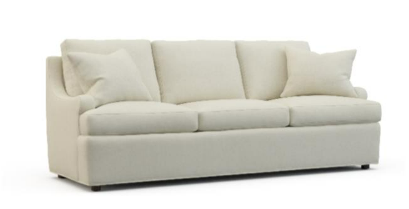Raine Mahdi, founder of sourcing platform Zipfox, says country’s proximity to US market remains a key advantage
SAN DIEGO — Recall how at the height of the pandemic, supply chain issues and high container costs had many in the industry fleeing to Mexico for solutions.
Now that those issues have largely been resolved — particularly as container rates have fallen below $4,000 — many have now returned to Asia.
But one entrepreneur who has spent plenty of time sourcing in Asia over the years suggests that furniture importers should not abandon Mexico, at least not anytime soon.

Raine Mahdi is the founder and chief executive officer of Zipfox, an online sourcing platform for factories mostly in Mexico that produce furniture, cabinetry, apparel, packaging materials and industrial building materials. It aims to connect these factories with customers in the U.S. seeking these types of products.
Soft-launched about a year ago, the site has more than 100 Mexican source furniture plants so far, a number that Mahdi says is growing all the time as his team continues to add new resources to the database.
Home News Now recently spoke with Mahdi not only to learn more about the concept but also to ask why now?, particularly when the tide appears to have turned back into Asia’s favor.
We thought his answers were worth noting as they pointed to the necessity of a diverse global supply chain because of unrest in Asia with the war in Ukraine and the potential for further upheaval — including potentially higher tariffs — between China and the U.S.
“I would say the same thing in the furniture category that I would say of most product categories — there’s obviously been this historical reliance on China … and people are realizing that diversity is necessary and nearshoring has its advantages,” he said. “The furniture industry understands that as well because furniture exports from Mexico grew about 20% to 25% last year. I think the cat’s already out of the bag.”
He said that his company — including a team that has attended the Guadalajara furniture show — has identified some key manufacturers that have been vetted based on how long they have been in business, who they are producing for currently, the quality of their production and their current capacity. Users of the site can do a search by product category and also receive quotes for various products, estimated shipping rates and order updates. The site also offers payment protection should the purchaser encounter a problem with the product or order.
“For the last few months, we have been trying to add as many furniture suppliers as we can,” he said. “We have a good amount of the contract manufacturing that exists in Mexico on the site now and we are adding new ones every day. … Furniture is actually the first category we have chosen to go very deep on in terms of the amount of supply. It is what we chose because there is such a great demand for it and there is such a great amount of capacity and capability that exists in Mexico. It’s such an important export category for them already.”
Mahdi doesn’t discount that some may have returned to Asia for lower pricing or perhaps even more consistent quality — although as an importer himself, he says that poor quality exists everywhere, even in China. That said, he believes the pandemic taught everyone about the need for a more diverse supply chain.
“It is about mitigating risk here that becomes the new driver aside from cost competitiveness,” he said. “There are some other motivating factors that help in not being so black and white and binary about price.”
He agrees that lower container costs are a major factor that have shifted things more toward Asia’s favor. But he notes those too can fluctuate widely, although no one really expects them to rise to pandemic levels anytime soon.
Another important factor in Mexico’s favor, he said, is its proximity to the U.S. market.
“Speaking from the buying side, lead time is something that obviously people see as an advantage, too,” he said, adding that this advantage will never change. In addition, he noted that Mexico’s infrastructure continues to improve, which is evidenced by the building of industrial parks that are now home to factories of major Chinese producers such as Man Wah, Kuka and Zoy, to name a few.
And while container costs may be lower for now, he noted that other factors, such as China tariffs, also continue to have an effect on landed costs. He adds that complex geopolitical issues, ranging from the war in Ukraine to ongoing concerns about China’s relations with Taiwan, could have an impact on global trade overnight.
“If the relationship between China and Russia and the U.S. is not in the news this week, you kind of forget about the amount of risk you are taking on there,” he said. “And then all of a sudden China is doing military drills in the ocean and you say ‘we have to get out of there.’”
He recalls how he was importing from China when the trade war started that resulted in tariffs of 25% on many industrial and consumer products starting around mid-2018.
“I was completely blindsided,” he said. “We had containers on the water and there was nothing we could do about it. We were going to have to eat the tariff. When that first happened, everybody was panicking and couldn’t believe this just happened. And that is when people started moving to other countries such as Vietnam and wherever else they could try to find a comparable supplier and get set up quickly. It’s just not smart to operate that way and some people went out of business because they couldn’t get there fast enough.”
While no one anticipates China tariffs going up further right away, it’s a situation he said that businesses all over need to prepare for with a good backup sourcing plan.
The goal here is not to create panic, but a sense of preparedness should things get worse, whether we’re talking an increased tariff or a war.
This part reminded me of a story I wrote about 18 years ago about Four Hands primarily sourcing in India during its earlier years. Then came news of a potential nuclear conflict between India and Pakistan around 1998. While Four Hands did not abandon India, it broadened its sourcing mix throughout Asia and now even sources in North America to avoid the fallout – no pun intended – from such a potential global catastrophe.
The Zipfox platform eventually plans to expand to include sourcing in Central and South America, Europe and parts of Asia. But for now, Mahdi said, Mexico makes the most sense, given its proximity to the U.S. market and the value that can represent in finished product costs.
He also acknowledges the need for quality and said that’s where companies also can plan ahead and be judicious in the selection of a source factory.
“I think the most important thing to do is just be careful in your approach to any new supplier whether it’s in Asia or in Mexico,” he said. “Take careful steps, request samples and prototypes, take your time and do it right. Start with a small order and do an inspection on-site and make sure you are getting what you discussed. Then working through our platform, you have payment protection, so if you get something different from what you discussed, at least you have that protection and you can get your money back.”
But the biggest protection — and precautionary measure — he sees companies affording themselves is keeping a country like Mexico in mind for the obvious benefits it still presents: proximity to the market, plentiful raw materials and an able work force.
“What I always tell people is that it doesn’t hurt to have a backup supplier in Mexico, even if that is all it is for you,” he said. “If you keep your supply chain in China for now, but at least start setting up a backup supplier in Mexico — and give them 10% to 15% of your business — at least you will have something set up there in case you need to make a larger shift.”





